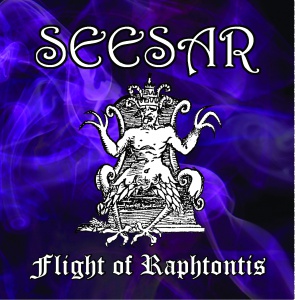Seesar - Flight of Raphtontis

Reads: 3444 times
69%
In "At the mountains of madness" story by H.P. Lovecraft style of painting of Elder Things in its most glorious period is compared to the works of certain futurists. It is not surprising that it was Luigi Russolo, futurist and precursor of noise music, who’s art was flourishing during literary activity from The Loner from Providence, indicated by Seesar next to Cthulhu creator as his inspirer. Ghosts of the two figures – breakthrough ones - meet in "Flight of Raphtontis", filthy dark ambient reflecting fictitious of forefathers nightmares.
It seems that his actual ethnomusicologist diploma Will Connor got at Miskatonic University. And although this may not be true, concept is appealing. Alternative legends, "ancient" myths and rituals, like Howard Phillips will describe - "repulsive" folklore - read in the "Necronomicon" could easily become the subject of his doctoral dissertation, and his first album – an effect from hyperborean research and exotic beliefs having source on Leng plateau and Arabian deserts.
In fact, some of the presented percussion’s solutions were created during university study of the author. And these are unusual solutions: bike, hinges, pots’ covers. It gives the symptomatic effect for Lovecraft's stories narrators, who are always accompanied by sensed, familiar to subconscious, but a stranger to conscious terror – in case of listener to mind’s perplexity contribute unusual, known-unknown instruments in environment of traditional, gaining by sinister landscapes in strength. Clearly these extravagant percussions can be heard in the title one composition – translation of flapping winged terror - and in the "Nyralathotep".
From regular anxiety, lurking horror (which, however, is sometimes accompanied with growing panic, focusing at the end on quite ordinary sounds, like characters in H.P.L. novels almost losing their senses in the end by presence in unusual place of everyday’s phenomena), from this anxiety in "Elder Things Below Kharkov Station" to crawling through creaks chaos - tension in each track keeps to the end, sometimes - as in "The Grease of Tsathoggua"- allowing listener to reach the peaks of fright. This happens there quickly. By a complex polyphony of extremely diverse noise timbres, piercing howl of the wind in the ice tops gradually reveal others, more justifying fear sounds: quiet growl, odiosa of moans from the depths, tremors, scratching, getting stronger and faster, the further into underground corridors, from which interior flows with a whistle stinking air, at last chirping and fluttering forcing to hysterical escape through the darkness and last heavy steps of the hunting thing left behind, in depths of the earth.
As you can see, dr Will Connor managed not only to create perfect illustrative music, but also a separate structure, which is located and develops in Lovecraft like mythology. Characteristic rhythm of this horror stories classic is reflected in compositions, and literature itself reflects in sounds as in a mirror. Seesar not only directly refers to that by titles and dark ambient illustrations, but imposes on his work atmosphere and attitudes typical for his readers and characters - seeking the inscrutable despite obvious danger, attracted by it. In that attraction helps Seesar hypnotic trance, in which he puts in, aided sometimes by ritual drums and structures - as in both parts of "Call to the Festival" - combined with blasphemous, cadaverous sacrament and procession - or in "Worshipping R'taq" with procession, during which is repeated monotonous, primitive theme emphasized with stronger strikes. Even more specific sound visions in the last mentioned composition are so vague and hazy that intrigue and harness to work the whole imagination.
Completely from clear rhythm to the monstrous ambient spaces resign less tangible, ongoing slowly nightmares "Child of YIG," and "What the Moon Brings". Sick, digested by fever onirism is fully revealed in "Jewel of Dylath-Leen". Sand storms, muted drums in the back of skull play to the upcoming doom from heaven in disguise - you can hear it all here.
Lovecraftesque in form, Lovecraftesque in contents project only repeats what, however, can only be done by Lovecraft - stories were connected by the same overloaded style, but also by many common parts. References to them can accustom to too much repetition. It is not Kadath yet, but Raphtontis in their flight rise quite high.
Tracklist:
01. Call to the Festival 01
02. Child of Yig
03. The Grease of Tsothoggua
04. What the Moon Brings
05. Call to the Festival 02
06. Elder Things Below Kharkov Station
07. Flight of Raphtontis
08. Jewel of Dylath-Leen
09. Worshipping R'taq
10. Nyralathotep in Ten Secs
Other articles:
It seems that his actual ethnomusicologist diploma Will Connor got at Miskatonic University. And although this may not be true, concept is appealing. Alternative legends, "ancient" myths and rituals, like Howard Phillips will describe - "repulsive" folklore - read in the "Necronomicon" could easily become the subject of his doctoral dissertation, and his first album – an effect from hyperborean research and exotic beliefs having source on Leng plateau and Arabian deserts.
In fact, some of the presented percussion’s solutions were created during university study of the author. And these are unusual solutions: bike, hinges, pots’ covers. It gives the symptomatic effect for Lovecraft's stories narrators, who are always accompanied by sensed, familiar to subconscious, but a stranger to conscious terror – in case of listener to mind’s perplexity contribute unusual, known-unknown instruments in environment of traditional, gaining by sinister landscapes in strength. Clearly these extravagant percussions can be heard in the title one composition – translation of flapping winged terror - and in the "Nyralathotep".
From regular anxiety, lurking horror (which, however, is sometimes accompanied with growing panic, focusing at the end on quite ordinary sounds, like characters in H.P.L. novels almost losing their senses in the end by presence in unusual place of everyday’s phenomena), from this anxiety in "Elder Things Below Kharkov Station" to crawling through creaks chaos - tension in each track keeps to the end, sometimes - as in "The Grease of Tsathoggua"- allowing listener to reach the peaks of fright. This happens there quickly. By a complex polyphony of extremely diverse noise timbres, piercing howl of the wind in the ice tops gradually reveal others, more justifying fear sounds: quiet growl, odiosa of moans from the depths, tremors, scratching, getting stronger and faster, the further into underground corridors, from which interior flows with a whistle stinking air, at last chirping and fluttering forcing to hysterical escape through the darkness and last heavy steps of the hunting thing left behind, in depths of the earth.
As you can see, dr Will Connor managed not only to create perfect illustrative music, but also a separate structure, which is located and develops in Lovecraft like mythology. Characteristic rhythm of this horror stories classic is reflected in compositions, and literature itself reflects in sounds as in a mirror. Seesar not only directly refers to that by titles and dark ambient illustrations, but imposes on his work atmosphere and attitudes typical for his readers and characters - seeking the inscrutable despite obvious danger, attracted by it. In that attraction helps Seesar hypnotic trance, in which he puts in, aided sometimes by ritual drums and structures - as in both parts of "Call to the Festival" - combined with blasphemous, cadaverous sacrament and procession - or in "Worshipping R'taq" with procession, during which is repeated monotonous, primitive theme emphasized with stronger strikes. Even more specific sound visions in the last mentioned composition are so vague and hazy that intrigue and harness to work the whole imagination.
Completely from clear rhythm to the monstrous ambient spaces resign less tangible, ongoing slowly nightmares "Child of YIG," and "What the Moon Brings". Sick, digested by fever onirism is fully revealed in "Jewel of Dylath-Leen". Sand storms, muted drums in the back of skull play to the upcoming doom from heaven in disguise - you can hear it all here.
Lovecraftesque in form, Lovecraftesque in contents project only repeats what, however, can only be done by Lovecraft - stories were connected by the same overloaded style, but also by many common parts. References to them can accustom to too much repetition. It is not Kadath yet, but Raphtontis in their flight rise quite high.
Tracklist:
01. Call to the Festival 01
02. Child of Yig
03. The Grease of Tsothoggua
04. What the Moon Brings
05. Call to the Festival 02
06. Elder Things Below Kharkov Station
07. Flight of Raphtontis
08. Jewel of Dylath-Leen
09. Worshipping R'taq
10. Nyralathotep in Ten Secs
Other articles:
- Seesar - The Silver Key - 2015-02-04 (Music reviews)
